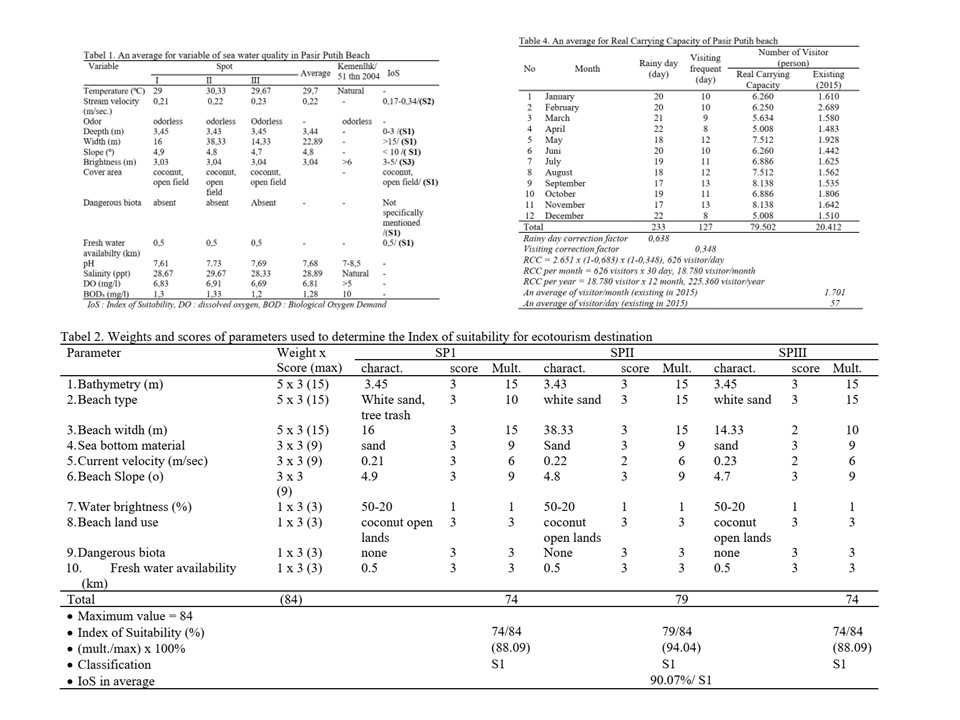Carrying Capacity and Suitability Indexs of Pasir Putih Beach for Ecotourism designation in Manokwari West Papua
DOI:
https://doi.org/10.46252/jsai-fpik-unipa.2023.Vol.7.No.2.190Keywords:
domestic leisure destination, favorable local, physical and real tourist capacityAbstract
Pasir Putih is popular beach and favorable destination for local and domestic tourists in Manokwari. Since becoming the capital city of Papua Barat province in 2000, numbers of tourists have grown significantly. However, tourist suitability index and real carrying capacity as well as physical carrying capacity of this area were not determined yet. This research is designed to determine tourist suitability index, examine sea water quality, determine physical carrying capacity of area, real carrying capacity, and to investigate the tourist perception on management and nature for future development and promotion. Survey and questionare were used to collect the data and analysed using Microsoft excel and presented in Figures and Tables. The results indicate that Pasir Putih beach has a tourist suitability index of 90% for highly suitable. Sea water qualities are in fufillment to the Ministry of Environment and Forestry Regulation, 51/MENKLH/2004 for standard for sea water quality for beach tourism activity. The real carrying capacity for Pasir Putih beach is 626 visitor per day and physical carrying capacity of area is 1.486 visitors, which can be divided into five tourism activity of beach recreation, beach sport, swimming, snorkeling, and boat cycling. Beach swimming is the most favorable activity (44%). In addition, major tourists (54%) have a great experience with the highest satisfaction, but the majority (67%) demanding for improving public facilities.
Downloads
References
BPS. (2017). Kabupaten Manokwari Dalam Angka 2017. in Indonesian.
Dahuri, R., Rais, J., Ginting, S. P., & Sitepu, M. J. (1996). Pengelolaan Suberdaya Wilayah pesisir dan Lautan Secara Terpadu. Jakarta: PT. Pradnya Paramita.
Daneshvar, M. R. M., Khatami, F., & Zahed, F. (2017). Ecological carrying capacity of public green space as a sustainability index of urban population: a case study of Marshad city in Iran. Journal of Modelling Earth System Environment, 3, 1161-1170. http://doi:10.100/s40808-017-0364.2
Kepmenlhk. (2004). Keputusan Menteri Lingkungan Hidup No. 51 Tahun 2004 Tentang Baku Mutu Air Laut Untuk Wisata Bahari.
Libosada, Jr. C. M. (2009). Business or Leisure? Economic development and resoruces protection- Concepts and Practices in Sustainable ecotourism. Journal of Ocean & Coastal Management, 52, 390-394. https://doi:10.1016/j.ocecoaman.2009.04.004
Odum, E. P. (1971). Fundamental of ecology, Philadelphia: W.B. Sounders Company.
Pushidrosal. (2019) Rujukan nasional Data Kewilyahan Republik Indonesia. http://www.pushidrosal.id (acccessed in December 2nd, 2019), in Indonesian.
Setiawan, N. (2007). Penentuan ukuran Sampel memakai rumus Slovin dan Tabel Krecjie-Morgan. http://www.pustaka.unpad.ac.id (accessed March 2nd, 2020).
Triyanto, M.A. (2014). Kajian Pengembangan Ekowisata Pantai di Kabupaten Manokwari (Studi kasus di pantai Yen-Beba) Thesis. Institut Pertanian Bogor, (in Indonesian).
EPA. (2020). Dissolved Oxygen and Biocehmical Oxygen Demand. https://archive.epa.gov/water/archive/web/html/vms52.html
Rintelen, V.,K., Arida, E., & Häuser, C. (2017). A review of biodiversity-related issues and challenges in megadiverse Indonesia and other Southeast Asian countries. Research Ideas and Outcomes, 3, e20860. https://doi.org/10.3897/rio.3.e20860.
Yulianda, F. (2007). Ekowisata Bahari sebagai Alternatif Pemanfaatan Sumberdaya Pesisir Berbasis Konservasi. Disampaikan pada Seminar Sains 21 Februari 2007 pada Departemen Manajemen Sumberdaya Perairan, Fakultas Perikanan dan Ilmu Kelautan. Institut Pertanian Bogor.
Yulianda, F., Fahrudin, A., Adrianto, L., Hutabarat, A. A., Harteti, S., Kusharjani., & Kang, H. S. (2010). Book 3 Pengelolaaan Pesisir dan secara Terpadu. Pusdiklat Kehutanan – Departemen Kehutanan RI dan SECEM – Korea International Cooperation Agency. Cetakan Ketiga. Bogor. Jawa Barat.
Zacarias, D. A., William, A. T, & Newton, A. (2011). Recreation Carrying Estimation to Support Beach Management at Pria de Faro, Portugal Applied Geography, 31, 1075-1081.

Downloads
Published
How to Cite
Issue
Section
License
Copyright (c) 2023 Sahirudin Sahirudin, Wahyudi wahyudi, Paulus Boli

This work is licensed under a Creative Commons Attribution-ShareAlike 4.0 International License.


















